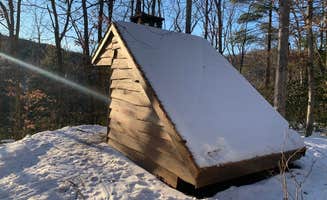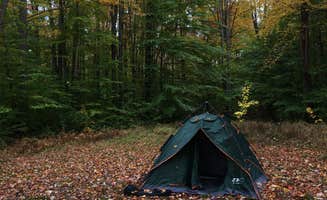Tent camping near Reno, Pennsylvania offers unique wilderness experiences within the Allegheny National Forest region. The area sits at the confluence of several watersheds, creating diverse ecological habitats across elevations ranging from 1,200 to 1,600 feet. Winter camping temperatures can drop below 20°F, while summer brings moderate humidity and daytime temperatures typically between 75-85°F.
What to do
Hike to Hector Falls: Located about a mile from Forestry Road Dispersed Campsite, this waterfall features a 20-foot drop with interesting rock formations. "It's about 3/4 a mile hike into the woods. The falls are really cool to look at, and has some cool rock formations. Be careful the cliffs are about a 20 ft straight drop," notes camper Bob J.
Paddle on local waterways: Many primitive camping options offer water access, particularly Private Island w/ Paddle Moor Co. which provides a unique island camping experience. "The option to have lights on or off was also a joy. When it was dark (pitch black) you could see all the fireflies. To be honest that was like a show in itself and made it also worth every penny of how beautiful it was," writes Jessica Z.
Explore mountain biking trails: The region offers technical terrain for cyclists of various skill levels. Near Mountain View Camps, camper Richard C. suggests you can "Hit the mountain bike track, explore the ruins on the game lands, and might even see an albino fawn."
Winter activities: Many dispersed sites remain accessible during colder months. Ian B. reports about Forestry Road: "Super peaceful. It was freezing, quite literally, with nights in the low teens. The melting and refreezing had made the roads and surrounding trails a little slippery so I would be cautious if traveling alone."
What campers like
Established fire rings: Many primitive sites maintain stone fire rings, even without other amenities. At Loleta Road Dispersed Campsite, camper Todd H. notes, "This is my first time dispersed camping and the spot is nice for a first go. Was able to drive in which is why I chose this area."
Privacy between sites: Several campgrounds design their layouts to maximize solitude. "The shelters are perfectly positioned to be private from one another, each looks out over the forest," explains Britt B. about Wolfkiel Run Shelters.
Wildlife viewing opportunities: The forests support diverse animal populations. At Mountain View Camps, you might "even see an albino fawn," according to Richard C., while other areas have documented bear activity requiring proper food storage.
Seasonal variations: Different camping experiences await throughout the year. "I have stayed in the summer with my sons and it is better. Despite the cold and ice there were others out in it," mentions Ian B. about winter camping at Forestry Road.
What you should know
Road conditions vary significantly: Many access roads are unpaved and can become challenging in wet weather. At Forestry Road Dispersed Campsite, one camper warns, "There are multiple spots along the main forest road. Some you can drive your car in and tuck it back. Other spots you can't take your car at all."
Wildlife precautions required: Bears are active in this region. Mystic S. shares a direct encounter: "I was meditating in my car one evening and a bear stood up and pushed against my window. Definitely be sure to pack up all food and trash at night. The bears are skittish, but they will find you if there's food in your camp!!"
Limited facilities: Most dispersed sites lack basic amenities. Anne W. notes about Loleta Road: "We stayed here in March, so there weren't leaves back on the trees yet which meant we could see the road (and the road could see us). Not a huge deal, just not very private."
Seasonal vegetation changes: Campsites can become overgrown in summer months. David B. advises about Forestry Road: "Way too grown in as of August. Didn't end up staying here. May be a good spot in the fall once the grass dies."
Tips for camping with families
Consider private property options: Some landowners offer more amenities than public lands. At Quiet and Secluded, Clyde A. reports, "Rolled up on the later side but was welcomed kindly by the owner Bill. Beautiful spot. Clean amenities!"
Pack proper footwear: Rain is common in the region. One experienced camper suggests, "It rains a lot so keep your slip-ons near the door," when staying at primitive sites around the Allegheny National Forest.
Bug protection essential: Ticks and other insects are prevalent in warmer months. Ian B. warns, "Bring tick/bug spray. Found several on my boys and me," during their stay at Forestry Road.
Know cell service limitations: Coverage varies significantly throughout the forest. Mystic S. shares, "There is spotty cell service through the forest, usually you can walk around for a couple minutes and find some. I managed to get an average of 3-4 bars of 5g every day."
Tips from RVers
Length restrictions apply: Many forest roads have tight turns limiting larger RVs. While some sites can accommodate modest-sized travel trailers, Mark M. notes about Forestry Road, "I have a 25 foot travel trailer. I found numerous spots on SF-160."
Check road clearance: Some dispersed camping access roads have uneven surfaces or significant ruts. Having high-clearance vehicles helps reach more remote sites, especially after rainfall.
Know emergency services access: Some campers report needing assistance. One camper at Forestry Road shared, "My car battery died while I was out there, the company that helped me jump start found me with no problems, they do it a lot."




